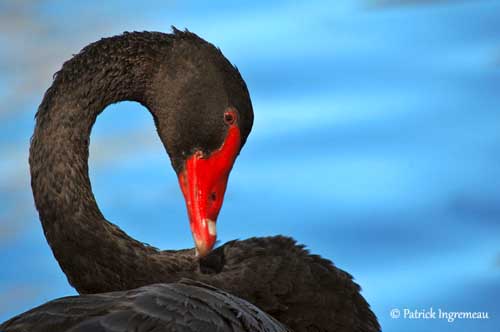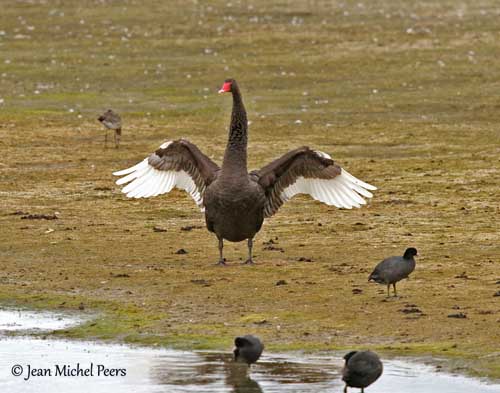
Fr: Cygne noir
All : Schwarzschwan
Esp : Cisne Negro
Ital : Cigno nero
Nd: Zwarte Zwaan
Sd: Svart svan
Photographers:
Patrick Ingremeau
TAMANDUA
Jean Michel Peers
JMPN PHOTOGRAPHIE
Nicole Bouglouan
PHOTOGRAPHIC RAMBLE
Texte by Nicole Bouglouan
Sources:
HANDBOOK OF THE BIRDS OF THE WORLD vol 1 by Josep del Hoyo-Andrew Elliot-Jordi Sargatal - Lynx Edicions - ISBN: 8487334105
GUIDE DES CANARDS, DES OIES ET DES CYGNES – de Steve Madge - Delachaux et Niestlé - ISBN: 2603013769
BirdLife International (BirdLife International)
Birds in backyards (Birds Australia and Australian Museum)
XENO-CANTO – Sharing Birds sounds from around the world
Black Swan
Cygnus atratus
Anseriforme Order – Anatidae Family
BIOMETRICS:
Length: 110-140cm
Wingspan: 160-200 cm
Weight: 3700-8750 g
DESCRIPTION:
The Black Swan is the emblem of Western Australia. Its black silhouette appears in the Coat of Arms of the state.
The adult has black plumage overall, except the white alula, primaries and outer secondary flight feathers, usually hidden at rest on closed wings. The flight feathers show crumpled effect.
The bill is red, with subterminal white band and pinkish nail. The bare face and the lores are red. The eyes are whitish or reddish. Legs and webbed feet are black.

The female has similar appearance but she is smaller, with slightly duller bill and eyes.
The juvenile has paler bill. Its plumage is browner with greyish mottling and pale-tipped feathers.
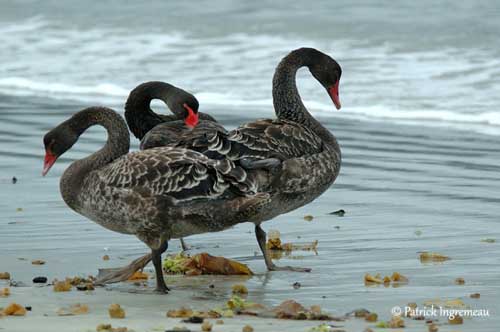
VOICE: SOUNDS BY XENO-CANTO
The Black Swan’s typical call is a trumpeting, sharp and fairly melodious sound given while flying or swimming.
Other weaker calls are uttered when several birds are on the water, such as hisses, grunts, or even dog-like barking when they are in family groups.
HABITAT:
The Black Swan frequents mainly large lakes and lagoons with relatively shallow permanent waters, fresh or brackish.
But outside the breeding season, it can be seen on rivers and coastal waters.
RANGE:
The Black Swan is found in Australia and Tasmania. It has been introduced in New Zealand, and now well established, after complete extinction due to intensive hunting.
This species is sedentary in suitable habitat, but the swans may wander from ephemeral waters, and erratic dispersions are frequently observed.
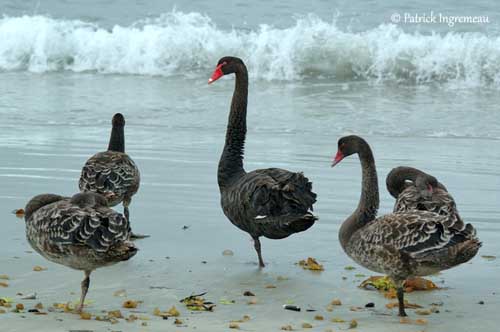
BEHAVIOUR:
The Black Swan feeds almost exclusively on plant matter such as aquatic plants, algae and pondweeds.
It forages by dabbling on surface with immerged head and neck to get the vegetation under the surface, and by upending. It also grazes in nearby grasslands and flooded fields.
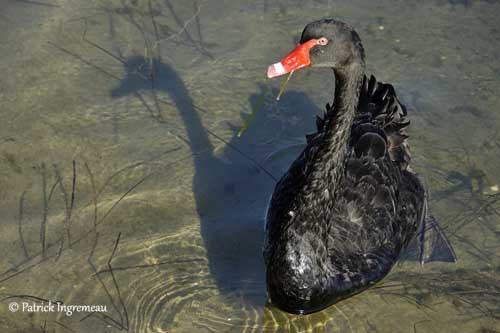
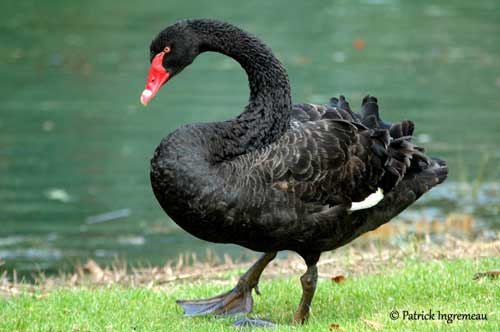
This is a gregarious species. The birds may gather at lakes in large numbers, up to several thousands of birds.
After the nesting period, they gather in flocks for moulting and then, they perform post-breeding dispersions.
The Black Swan is largely monogamous and the pair-bonds are life-long.
Some pairs are the same sex and in this case, two males steal the eggs, or form a “threesome” with one female. Once the eggs are laid, they drive the female away from the nest and perform all the nesting duties.
The displays between both mates yet paired affect only the two partners. The copulation takes place on water. The male grips the female’s hindneck during the act.
The copulatory behaviour is an important way to strengthen the pair-bonds.
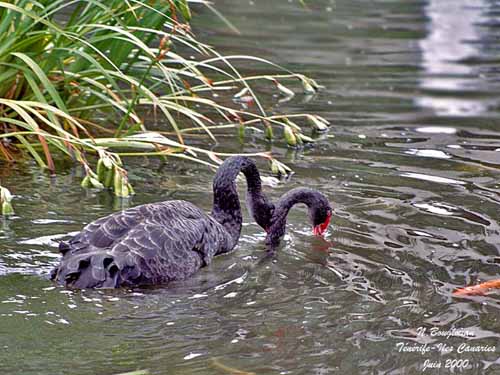
They are highly territorial and defend strongly the nesting area.
FLIGHT:
The Black Swan has powerful wings which allow strong flight with permanent wingbeats.
REPRODUCTION:
The breeding season varies according to the range, but usually occurs during the highest water level period, in February in NW Australia, and in August in the western part of the continent.
The Black Swan nests in colonies or isolated pair, in the riverine vegetation close to the water, or on islets. The nests are very close to each other within the colonies.
The large nest is a mound of floating vegetation, but it may also be placed on the ground. It can reach a diameter of two metres, and 40 cm high. It is made with twigs, stems, sticks and grass, often fixed together with mud.
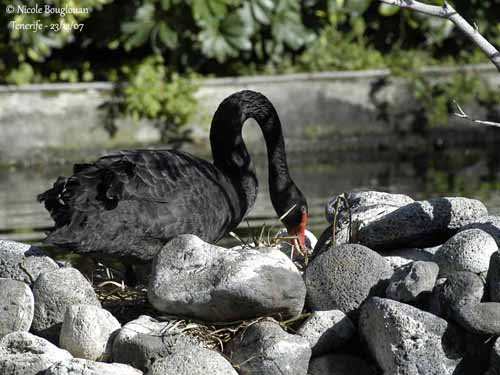
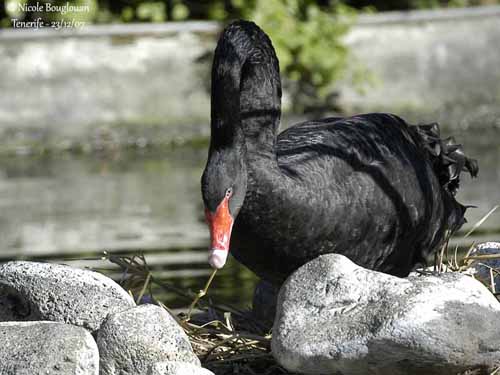
The female lays 5-6 greenish eggs. The incubation lasts about 36-40 days, shared by both parents.
The chicks are precocial and they can feed and swim just after hatching. They are covered in pale grey waterproof down. They fledge 150-170 days after hatching, sometimes sooner if there are abundant food resources.
They are sexually mature between 18 and 36 months of age.
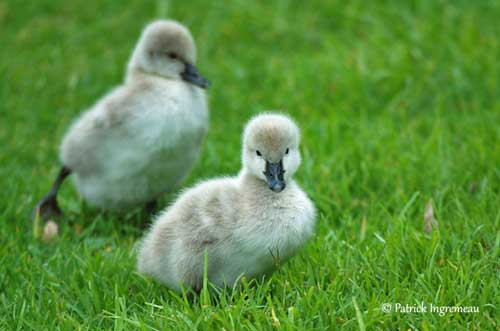
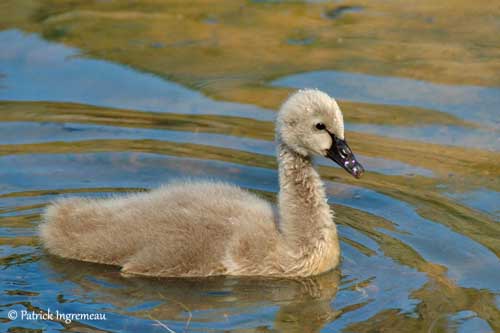
DIET:
The Black Swan feeds almost exclusively on plant matter, aquatic plants such as Typha, Myriophyllum and Ruppia. It also takes algae and pondweeds (Potamogeton).
It feeds by dabbling and upending.
PROTECTION / THREAT S/ STATUS:
The Black Swan is widespread and locally common in Australia and New Zealand where it was formerly more abundant.
This species is not currently threatened.
